One of the things that I think most of us with celiac disease would really like to do at some point is modify our favorite recipe (recipes?) to make them gluten-free. Don’t get me wrong – there are a lot of great recipes out there that were designed from scratch to be gluten-free; one can hardly claim to be deprived when you have the wealth of the internet and all those chefs’ and bakers’ genius at your fingertips! But sometimes there is that one recipe, sitting in the back of your mind (or recipe folder), calling forth memories of its delicious smell as it bakes, the perfect combination of flavors, the heavenly texture…
Well, I have a few such recipes. Some that I’ve worked on over the years, and some that I haven’t yet attempted to modify. It occurred to me that perhaps some of you out there might be interested in how I do this, and how you can learn to do it too.
So there are a few things right off the bat:
1 – Certain recipes are easier to modify. This is just reality when you’re eliminating a structural element of baking, which gluten is. Cookies, muffins, certain cakes (although these can start getting into tricky territory too), pancakes, quick breads, crêpes…all of these are easier to convert to gluten-free. These types of recipes are the place to start.
2 – Having an understanding of the basic ratios in baking and what they do is tremendously helpful. If you do not yet have Michael Ruhlman’s book Ratio and you want to convert a recipe, save yourself a lot of grief and go out and get his book first.
3 – Bake by weight, not volume. This goes hand in hand with the above point. Volume is too unreliable for so many reasons – scooping versus spooning flour into a measuring cup; each starch and flour has a different texture and weight, etc. Baking by weight is a game changer – now is the time!
With those points out of the way first, let’s move on to what I do when I’m working on a recipe. Which at the moment, I am.
This recipe is for the best oatmeal cookies ever. It comes from my college roommate’s former roommate. (Thank you Allison!)
So the first thing that I do is figure out what the amount of flour called for in the recipe works out to, roughly, in grams. A cup of all-purpose flour can be anywhere from 120-140 grams, depending on how it’s measured, so for my purposes, I used 125 grams/cup as my reference point. Here is the original recipe:
1 3/4 cups all-purpose flour
1 tsp baking soda
1/2 tsp salt
1 cup softened butter
1 1/4 cups packed brown sugar
1/2 cup granulated sugar
2 large eggs
2 T milk
2 tsp vanilla
2 cups chocolate chips
1 cup coarsely chopped nuts
1 cup oats
I’m leaving out the instructions for now – I’ll include them with recipe #4. (If you don’t care so much about the explanation of the process, go ahead and jump to the end; recipe #4 is where it’s at!) So with my quick little calculations and a little rounding, I settled on 220 grams of flour. I decided to split that 60/40, whole grain flours to starches, because I find that to be a fairly good ratio for keeping stuff together and creating a pleasant texture. In keeping with the oat cookie theme, I used gf oat flour (88 grams), and mixed that with potato starch (88 grams) and sweet white rice flour (44 grams). The recipe called to bake them at 375 degrees fahrenheit for anywhere from 7 to 14 minutes, depending on how crisp or chewy you like your cookies.
This first batch of cookies *really* spread! Which was not exactly what I was hoping for. Right below is a picture to show you what they look like. This cookie is a little brown; I over-baked the first pan slightly, but this is the only cookie left to photograph. We ate the rest. Even though they look a little strange, they are ridiculously good!)
Now I have some feedback to work with. Time to consult Ruhlman’s book and make some changes.
The first thing I do is figure out roughly what ratio the original recipe is using. In this case, it is very close to a 3:2:2 ratio by weight (3 parts sugar: 2 parts butter: 2 parts flour).
Looking at the cookie section in Ruhlman’s book, I see that the ratio for a basic shortbread cookie is 1:2:3 – (sugar:fat:flour). That’s dramatically different, but this is, after all, not a shortbread cookie. A drop cookie has a ratio that is closer to 1:1:1. That sounds more reasonable for what I’m attempting here, but I’m going to modify it from that (I explain more below). He also discusses the use of leavening agents like baking soda, powder and eggs, which are part of the original recipe and I will leave in, though I’m going to try switching the baking soda to powder, since I don’t see an acid in the recipe to activate the baking soda, which seems strange to me. Another noteworthy mention is that increasing the amount of sugar will give a crisper cookie. One more important point, since my original cookies spread so much and I would prefer they not, is that butter contains about 15% water – it contributes to the spreading.
Taking all of that and putting it together, here is my game plan for this next batch:
1 – I will take the ratio and bring it in to 2:1:2 (sugar:fat:flour). I want less sugar because I want less crispiness; less butter so the cookies will spread less; I am keeping the amount of eggs and flour consistent, but the overall effects that those ingredients have should be enhanced. I will shift the amounts slightly because I’m going to base the ratio on the weight of the eggs, even though they’re not part of the ratio).
2 – I am swapping out the baking soda for baking powder. I’m hoping that this will help give some loft to the cookies, since I didn’t see an acid to activate the baking soda in the original recipe and I’m not sure it was doing much of anything in the first place.
3 – I am omitting the milk. I’m pretty sure I don’t need the extra liquid. I’m hoping this will help decrease the spread of the cookies as well.
4 – I am changing the method of mixing slightly – apparently if you really cream the sugars and butter together until it’s light and fluffy (which I did the first time around) it aggravates the spreading issue. I will only mix the sugars and butter until combined this time.
Here is what recipe #2 looks like:
240 grams of flour (96 oat, 48 sweet white rice flour, 96 potato starch)
1 tsp baking powder
1/2 tsp salt
1/2 cup softened butter
65 grams white sugar
175 grams brown sugar
2 large eggs (roughly 120 grams)
2 tsp vanilla
2 cups chocolate chips
1 cup chopped nuts
1 cup oats
This second batch baked up to a drier, more cake-like cookie. It spread very little, and while I would like to show you a picture of them for comparison, and fully intended to, I am also new to food photography and forgot to before we ate them all. The good news is that they are still edible!
They were, predictably, a lot less sweet than the original recipe. My young taste testers preferred them to the first batch, though my husband and I liked the first ones better. I found that to be interesting. I’m not satisfied though; these cookies were just not like the kind of cookies I really like – either texture or taste-wise – so I need to aim for something about halfway between the two, I think.
I’ve decided that for the third batch, I will aim for a happy medium of 2.5:1.5:2. I’m hoping that will bring some of the spreading back and take the texture more towards a cookie; a little less dry. Maybe even bring back a little bit of the caramelized taste of the brown sugar that the first batch had.
Here is the recipe for batch #3:
240 grams of flour (96 oat, 48 sweet white rice flour, 96 potato starch)
1 tsp baking powder
1/2 tsp salt
3/4 cup softened butter
83 grams white sugar
225 grams brown sugar
2 large eggs
2 tsp vanilla
2 cups chocolate chips
1 cup chopped nuts
1 cup oats
This third batch turned out beautifully! Nice rise; chewier texture – just an all-around enjoyable cookie. I highly recommend this last recipe if you like your cookies slightly less sweet; it’s a very good cookie!
…however…
I think I’m going to go for one more try. Just because I’m curious as to what will happen, I’m going to leave the butter ratio as is and bring the sugar back up to roughly where it was at the beginning. This ratio will be 3:1.5:2. Batch #3 was so close; a very good cookie – what I’m looking for here, though, is spectacular!
So here is attempt #4, and my personal favorite:
Oatmeal Chocolate Chip Cookies (gluten-free)
240 grams of flour (96 oat flour, 48 sweet white rice flour, 96 potato starch)
1 tsp baking powder
1/2 tsp salt
3/4 cup softened butter
98 grams white sugar
262 grams brown sugar
2 large eggs
2 tsp vanilla
2 cups chocolate chips
1 cup chopped nuts
1 cup rolled oats
In a medium bowl, stir together the flours, baking powder and salt. In the mixer bowl (or a large bowl if mixing by hand), cream together the butter and sugars – but don’t overdo it! Add eggs one at a time and mix thoroughly. Add the vanilla and mix. Run the mixer on low and gradually add the dry ingredients. Mix until smooth. Fold in the chocolate chips, nuts and oats. Chill for at least an hour. Preheat the oven to 375 degrees. Drop by spoonfuls onto a baking sheet lined with parchment or silpats. Bake for around 9 minutes.
This fourth version was absolutely what I was after – a nice chewy texture, the perfect blend of flavors… Absolute perfection!
So that is how I do it, and how you can do it too – don’t be afraid to play around with your recipes, keep changing things, and be sure to call your friends and neighbors so you have a good group of taste testers to help you along the way! Happy modifying!
(As I play with and modify some of my favorite recipes, I will be sharing them, as well as any relevant information about how I went about making changes to the recipes so that you can get a better picture of the process behind the scenes with different types of recipes. Please feel free to share/link in the comments to any recipes that you have modified successfully, or recipes that you are working on.)

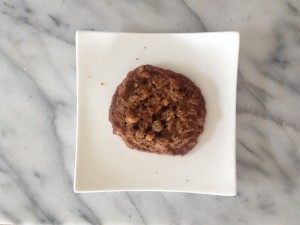
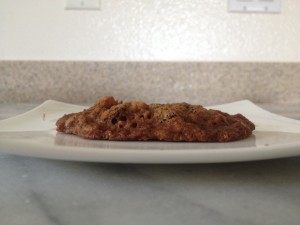
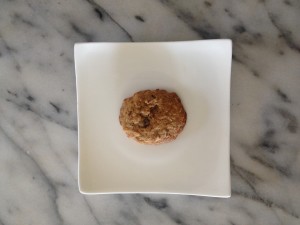
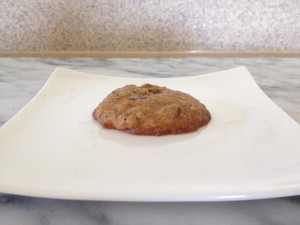
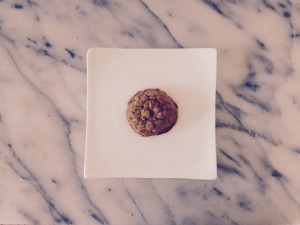
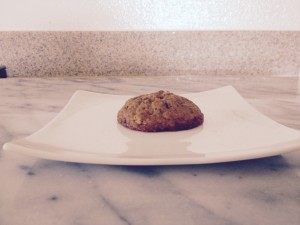
The adds another level of levening and helping the texture or crumb of the cookie. I took a cookie baking class at Orson Gygi and it was not gluten free. You could use dry milk powdered if you want to try another batch. Perhaps a different cookie I’m so proud of your efforts. Your a kitchen chemist. You do realize that don’t you.
That’s really interesting about the milk; I suppose I could try decreasing the amount of butter by a tablespoon or two and add the milk back in – certainly worth a try! I don’t think I have any powdered milk on hand anymore.
Thanks for the kind compliments.